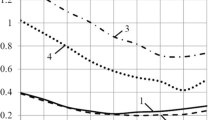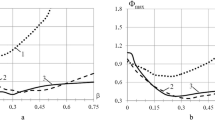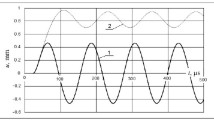The effect of the metallic layer thickness on the stress-strain state and strength of thick-walled metal-composite cylinders of total constant thickness under internal dynamic pressure produced by the explosion of a charge uniformly distributed along its axis in air at the constant total-to-running charge mass ratio \(\xi \) = 1.421 mm was numerically investigated. The strength of the cylinders was evaluated by the generalized Mises criterion. It is numerically and analytically proved that the strength of circularly reinforced cylinders from the composites of low tensile strength in the isotropy plane is primarily governed by the wave processes across the shell width and, as a consequence, by radial and axial tensile stresses, viz the larger they are, the lower the strength. Circumferential tensile stresses, on the contrary, improve the strength in most cases, i.e., only strengthen the structural element and increase the safety margin. Cylinders with four outer layer composites are examined. They are double-layered: the inner layer is steel (St20), the outer layer is a circularly reinforced composite. At given \(\xi \) and the total constant cylinder thickness \(H\), the optimum in strength terms ratio \({\beta }_{opt}\) of the metallic layer thickness \(h\) to \(H\) is strongly dependent on a composite (i.e., its physicomechanical characteristics) and varies within 0.3–0.7. The plastic deformation of the inner steel layer has a significant impact on the shell strength, the account of the plastic steel deformation substantially changes the dynamics of objects both qualitatively and quantitatively, thus, the strength function can be reduced by more than 50% compared to the elastic calculation. The strength of metal-composite cylinders is proved to be very sensitive to the wave phenomena along the radial coordinate. Sometimes at a certain ratio of layers \(\beta \) (about 0.7), the charge mass ratio \(\xi \) (and hence the absolute charge mass \(M\)) can be increased more than twice without deterioration of the strength requirements, while the \(\beta \) deviation by only 1.5% from that at given \(\xi \) would lead to the cylinder fracture.








Similar content being viewed by others
References
P. P. Lepikhin, V. A. Romashchenko, S. O. Tarasovska, and O. S. Beiner, “Dynamics and strength of metal-composite cylinders on internal explosion against the thickness and properties of metallic and composite layers. Part 1. Numerical simulation of thin- and medium-thickness cylinders,” Strength Mater., 54, No. 6, 997–1008 (2022). https://doi.org/10.1007/s11223-023-00475-x
P. P. Lepikhin, V. A. Romashchenko, O. S. Beiner, et al., “A program for numerical calculation of dynamic stress-strain state and strength of hollow multilayer anisotropic cylinders and spheres. Part 1. Program description,” Strength Mater., 47, No. 2, 249–256 (2015). https://doi.org/10.1007/s11223-015-9655-x
N. K. Naik, Y. Chandra Sekher, and Sailendra Meduri, “Damage in woven-fabric composites subjected to low-velocity impact”, Compos. Sci. Technol., 60, No. 5, 731–744 (2000).
Author information
Authors and Affiliations
Corresponding author
Additional information
* This study continues our previous publication [1]. Therefore, the through numbering of formulas and figures (starting from [1]) is maintained, as well as the abbreviations and symbols previously adopted in [1] are used. References are independent.
Translated from Problemy Mitsnosti, No. 1, pp. 55 – 70, January – February, 2023.
Rights and permissions
Springer Nature or its licensor (e.g. a society or other partner) holds exclusive rights to this article under a publishing agreement with the author(s) or other rightsholder(s); author self-archiving of the accepted manuscript version of this article is solely governed by the terms of such publishing agreement and applicable law.
About this article
Cite this article
Lepikhin, P.P., Romashchenko, V.A., Tarasovska, S.O. et al. Dynamics and Strength of Metal-Composite Cylinders on Internal Explosion Against the Thickness and Properties of Metallic and Composite Layers. Part 2. Numerical Simulation of Thick-Walled Cylinders and Effect of Stress Components on Strength*. Strength Mater 55, 44–57 (2023). https://doi.org/10.1007/s11223-023-00501-y
Received:
Published:
Issue Date:
DOI: https://doi.org/10.1007/s11223-023-00501-y




